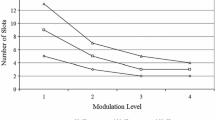Abstract
It is widely believed that dynamic operation in wavelength-routed optical networks could overcome the inefficiencies of static allocation in wavelength usage. In this paper this hypothesis is reviewed by quantifying the wavelength requirements in dynamic wavelength-routed optical networks and the comparison of these to those of the static approach. To do so, new analytical and heuristic lower bounds for the wavelength requirements in dynamic networks are proposed. They are used to evaluate the optimality of existing algorithms whose wavelength requirements are evaluated by means of simulation. Results show that dynamic wavelength-routed optical networks can save wavelengths only at low traffic loads (<0.4) and that the highest savings are achieved in sparsely physically connected networks.
Preview
Unable to display preview. Download preview PDF.
Similar content being viewed by others
References
Coffman, K.G., Odlyzko, A.M.: Growth of the Internet. In: Kaminow, I.P., Li, T. (eds.) Optical Fiber Communication - vol. IV-B: Systems and Impairments, pp. 17–56. Academic Press, San Diego (2002)
Agrawal, G.: Fiber-Optic Communication Systems, ch. 8, 3rd edn. Wiley-Interscience, Wiley & Sons (2002)
Post-deadline papers in Proceedings of 31st European Conference on Optical Communications. In: ECOC 2005, Glasgow, Scotland (September 2005)
Baroni, S., Bayvel, P.: Wavelength requirements in arbitrarily connected wavelength-routed optical networks. IEEE J. of Lightwave Technol. 15(2), 242–251 (1997)
Assi, C., et al.: Impact of wavelength converters on the performance of optical networks. Optical Networks Magazine 3(2), 22–30 (2002)
Odlyzko, A.: Data networks are lightly utilized, and will stay that way. Rev. Network Economics 2, 210–237 (2003)
Gerstel, O., Raza, H.: On the synergy between electrical and optical switching. IEEE Communications Magazine 41(4), 98–104 (2003)
Sengupta, S., Kumar, V., Saha, D.: Switched optical backbone for cost-effective scalable core IP neworks. IEEE Communications Magazine 41(6), 60–70 (2003)
Assi, C., Shami, A., Ali, M.: Optical networking and real-time provisioning: an integrated vision for the next - generation Internet. IEEE Network 15(4), 36–45 (2001)
O’Mahony, M.J., Simeonidou, D., Hunter, D.K., Tzanakaki, A.: The application of optical packet switching in future communications networks. IEEE Communications Magazine 39(3), 128–135 (2001)
Ross, S.: A first course in Probability, 6th edn., p. 206. Prentice-Hall, Englewood Cliffs (2002)
Yates, R., Goodman, D.: Probability and stochastic processes. A friendly introduction for Electrical and Computer Engineers, 2nd edn. Wiley & Sons, Chichester (1999)
Dorogovtsev, S.N., Goltsev, A.V., Mendes, J.F.: Pseudofractal sacle-free web. Physical Review E 65, 066122-1–066122-4 (2002)
Korotky, S.K.: Network global expectation model: a statistical formalism for quickly quantifying network needs and costs. IEEE J. of Lightwave Technol. 22(3), 703–722 (2004)
Düser, M., Zapata, A., Bayvel, P.: Investigation of the Scalability of Dynamic Wavelength-Routed Optical Networks. J. of Optical Networking 3, 667–686 (2004)
Mokhtar, A., Azizoglu, M.: Adaptive wavelength routing in all-optical networks. IEEE/ACM Transactions on Networking 6(2), 197–206 (1998)
Chlamtac, I., Ganz, A., Karmi, G.: Purely optical networks for terabit communication. In: Proceedings of INFOCOM 1989, Ottawa, Canada, vol. 3, pp. 887–896 (April 1989)
Düser, M., Bayvel, P.: Analysis of a dynamically wavelength-routed optical burst switched network architecture. IEEE J. of Lightwave Technology 20(4), 574–585 (2002)
Author information
Authors and Affiliations
Editor information
Editors and Affiliations
Rights and permissions
Copyright information
© 2006 Springer-Verlag Berlin Heidelberg
About this paper
Cite this paper
Zapata, A., Bayvel, P. (2006). Do We Really Need Dynamic Wavelength-Routed Optical Networks?. In: Gerndt, M., Kranzlmüller, D. (eds) High Performance Computing and Communications. HPCC 2006. Lecture Notes in Computer Science, vol 4208. Springer, Berlin, Heidelberg. https://doi.org/10.1007/11847366_49
Download citation
DOI: https://doi.org/10.1007/11847366_49
Publisher Name: Springer, Berlin, Heidelberg
Print ISBN: 978-3-540-39368-9
Online ISBN: 978-3-540-39372-6
eBook Packages: Computer ScienceComputer Science (R0)




